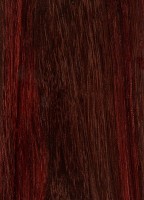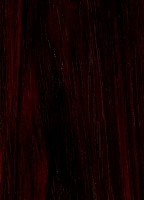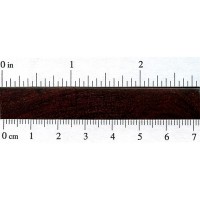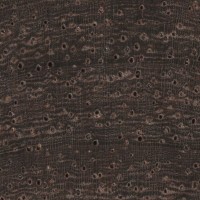 |
Common Name(s): Bois de Rose Scientific Name: Dalbergia maritima, Dalbergia louvelii Distribution: Madagascar Tree Size: 40-65 ft (12-20 m) tall, 1-2 ft (.3-.6 m) trunk diameter Average Dried Weight: 58 lbs/ft3 (930 kg/m3) Specific Gravity (Basic, 12% MC): .74, .93 Janka Hardness: 2,600 lbf (11,570 N) Modulus of Rupture: No data available Elastic Modulus: No data available Crushing Strength: No data available Shrinkage: Radial: 4.0%, Tangential: 6.7%, Volumetric: 10.8%, T/R Ratio: 1.7 |
Color/Appearance: Heartwood color is a vibrant magenta or reddish purple, sometimes with darker violet-black streaks. Overall color tends to darken with age to a deep purple to nearly black.
Grain/Texture: Has a fine uniform texture with a very high natural luster.
Endgrain: Diffuse-porous; large pores in no specific arrangement; solitary and radial multiples of 2-3; heartwood deposits (dark red) common; growth rings usually indistinct; rays not visible without lens; parenchyma diffuse-in-aggregates, vasicentric, aliform (winged), and banded (marginal). Heartwood extractives (violet) leachable in water.
Rot Resistance: No data available; being a dense rosewood, it is presumably very durable.
Workability: Bois de Rose is an excellent turning wood. Turns and finishes well, and takes a high natural polish.
Odor: Has a characteristic rosewood scent while being worked.
Allergies/Toxicity: Although severe reactions are quite uncommon, rosewood in the Dalbergia genus, (such as Bois de Rose), has been reported as a sensitizer. Usually most common reactions simply include eye, skin, and respiratory irritation. See the articles Wood Allergies and Toxicity and Wood Dust Safety for more information.
Pricing/Availability: International trade of this species is currently (and rightfully) restricted. National parks and other protected areas within Madagascar have been plundered for their valuable rosewood logs. At present, only residual stockpiles of small turning and carving blanks are available at very high prices.
Sustainability: Bois de Rose is listed on CITES appendix II under the genus-wide restriction on all Dalbergia species—which also includes finished products made of the wood. It is also listed on the IUCN Red List as endangered due to a population reduction of over 50% in the past three generations, caused by a decline in their natural range, and exploitation.
Common Uses: Musical instruments, inlay, fine furniture, carving, turned objects, and other small specialty wood items.
Comments: This sought-after and prized hardwood is only found on the African island of Madagascar. Bois de Rose is french for “rosewood,” and it is in the true rosewood genus (Dalbergia), and could rightly be referred to as Madagascar Rosewood. But to avoid confusion, the common name Madagascar Rosewood belongs to another tree species endemic to Madagascar: Dalbergia baronii.
- African Blackwood (Dalbergia melanoxylon)
- Amazon Rosewood (Dalbergia spruceana)
- Brazilian Rosewood (Dalbergia nigra)
- Burmese Blackwood (Dalbergia cultrata)
- Burmese Rosewood (Dalbergia oliveri)
- Cocobolo (Dalbergia retusa)
- East Indian Rosewood (Dalbergia latifolia)
- Honduran Rosewood (Dalbergia stevensonii)
- Kingwood (Dalbergia cearensis)
- Madagascar Rosewood (Dalbergia baronii)
- Sissoo (Dalbergia sissoo)
- Tulipwood (Dalbergia decipularis)
- Yucatan Rosewood (Dalbergia tucurensis)
Scans/Pictures: A special thanks to Steve Earis for providing the wood sample (endgrain 10x) of this wood species.
 |
 |
 |
 |





Light purple in color, changes color to brown when exposed to the sun.
Doesn’t look like bois de rose to me
I was fortunate to buy large stock of this wood. In my free time I like planing or sanding it just for a smell or to admire the “beetroot like” shavings.
Beautiful wood.
Bois de Rose is NOT the french for rosewood. The reality is a bit more complex. Bois de Rose is a traduction word for word of rose wood but thephrase/name apply only to D. Maritima.
Most other rosewoods are Palissandre in french
As a follow up While I never had a chance to work with the wood from the billet I pictured four years ago (having sold it), I did have a small piece of very thin dalbergia maritima that I bent and it a lot like Brazilian rosewood (dalbergia nigra) in that it’s oily and bends well with a bit of care. The oily rosewoods can burn rather easily and great care must be taken respecting any oily wood in this regard. Ditto for gluing. It’s lovely to French polish and rings like a bell! I would say it’s even better… Read more »
Always wanted some Bois de Rose, [dalbergia maritima] and finally got a great billet @16 years ago. Freshly sanded it is vivid purple–tyrian purple to be exact, and pink. French polished, it shines like a black opal. Breathtaking! None has come up on my radar since, except one warped thinwood piece sent as a sample. Brazilian is quite plentiful by comparison. No other rosewood can compare to this rare, gorgeous wood. I’ve been known to sand it just for the smell.
You don’t mention sapwood in this article,but this wood does indeed have a very, very, thin sapwood that is rarely seen, but it is there, it is creamy white, and often separated from heart wood with a dark black line. I had never seen this woods sapwood until I got my hands on an very old live edge piece.
I strongly disagree. This wood is not brittle. “Bois De Rose” wood
has more elasticity than “African Blackwood”. I am sure of it. “African Blackwood” is more stiff on the other hand and far less elastic.
I just worked with this species this morning. It works a lot like African blackwood – hard and somewhat brittle. The results can be beautiful. You have to “machine” it like stone or metal, more than cut it. Careful about overheating it. Burns easily.
I have not worked with this wood species yet but I hope that there can be more of it in the future… :)
Bois de Rose is listed on CITES appendix II under the genus-wide restriction on all Dalbergia species—which also includes finished products made of the wood. It is also listed on the IUCN Red List as endangered due to a population reduction of over 50% in the past three generations, caused by a decline in their natural range, and exploitation.
Musical instruments